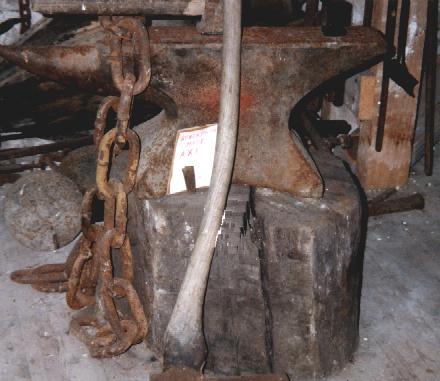The Smithy and the Forge
Almost any tool could be made or mended by the smith. This was quite apart from his skill at handling horses.
The Anvil

Iron heated in the forge fire could be beaten to whatever shape was needed using either the flat "face" or the round, pointed "beak" of the anvil. This anvil is mounted on a thick slice of wood to bring it to a convenient height for work.
Jack Enright of Buxton, Derbyshire, sent in these observations in July 2013:
I came across your website this evening, and spent a happy half hour browsing. I used to work for a smith in Somerset in the early 1970s, and thought this bit of info might be worth adding to the section on the forge.
One reason for having wood under the anvil was because of wood's elasticity. Especially if you use a hard and tough wood, such as oak or ash, what happens when the hammer hits the work is that some of the energy goes down into the wood, which then compresses a minute amount. A split-second later, the wood will stretch out to its full height again, like a spring. Now the distance it compresses and stretches is obviously only a minute amount - but I can assure you that you can feel the difference, even if just working at the anvil with a two and a half pound hammer, and even if the wood is only a foot or eighteen inches high.
The end result is that when the hammer strikes the work, the compression and stretch of the wood bounces the hammer back up - enabling you to work faster, and with less effort. This also means that you can get more work done in one 'heat'. Once you get the metal up to heat in the fire, you only have so many seconds to work it in its 'plastic' state before it cools down to the point where it hardens up. If you haven't finished, you then have to put it back in the fire for another 'heat' to finish the job. Saving even one heat on a big job not only gets the work done quicker, but saves on coal, too.
The smith I worked for (Geoff Amesbury, of Mark, in N. Somerset) told me that the old forges had a deep hole in the ground where they wanted the anvil, so that they could use a baulk of timber about 4 or 5 foot long. The longer it was, the more effective the spring action - and you can imagine the difference that made if you were working with a sledgehammer.
There was another thing I noticed, as well as the hammer bounce, when we started using the anvil on wood, rather than an angle iron frame; that anvil rang like a church bell!
I hope the above is of interest, and many thanks for putting all this information on line for anyone to access. I very much hope I get a chance to visit your museum at some time.
Reuben McCormack
Reuben was the smith at Penruddock Forge and shod Dalemain's ponies and horses for many years until the mid-1970s.
Reuben donated all his equipment to the Museum when he was stricken with illness in the 1970s. The anvil and the flexible but tough pigskin apron were essential parts of his equipment.
The Apron
 The apron protects the smith's legs from the heat of the forge fire, the hot metal, and the sparks from the forging activity; it can also protect him from the nail ends sticking up from the horse's hoof, if the horse pulls sharply away in the middle of shoeing. Some smiths cut fringes in the edge of the leather to make a brush that will not burn, for keeping their anvil face clean.
The apron protects the smith's legs from the heat of the forge fire, the hot metal, and the sparks from the forging activity; it can also protect him from the nail ends sticking up from the horse's hoof, if the horse pulls sharply away in the middle of shoeing. Some smiths cut fringes in the edge of the leather to make a brush that will not burn, for keeping their anvil face clean.
For Reuben it was precious as a symbol of his work. It is still flexible after 40 years on display.